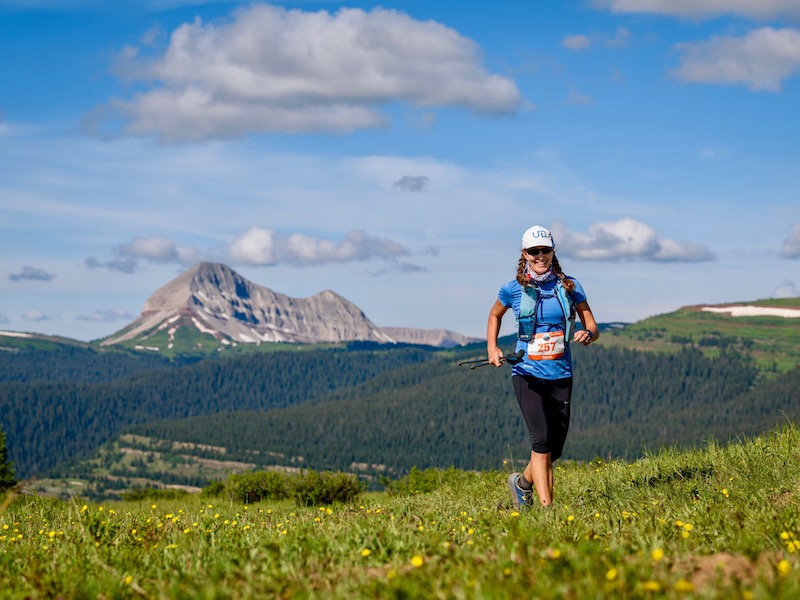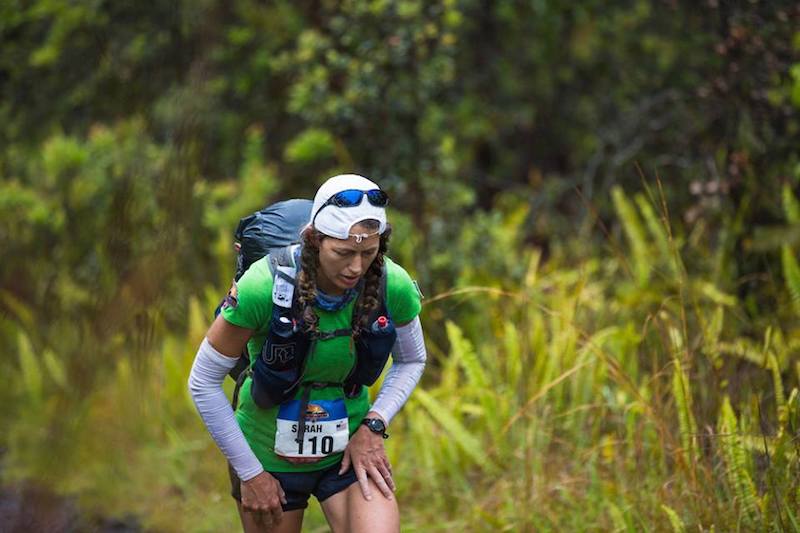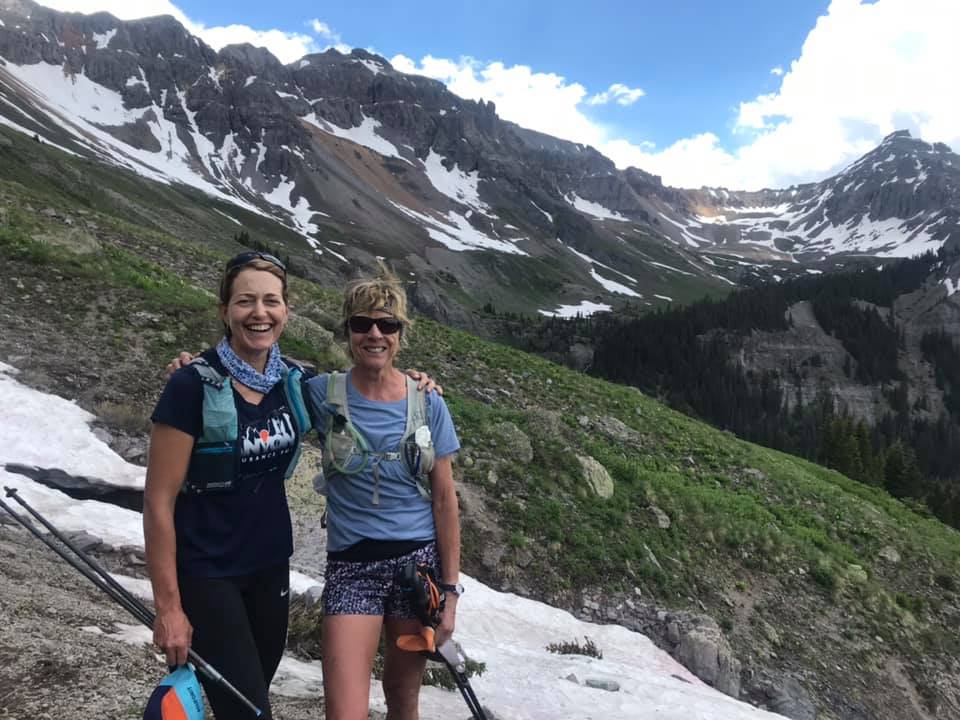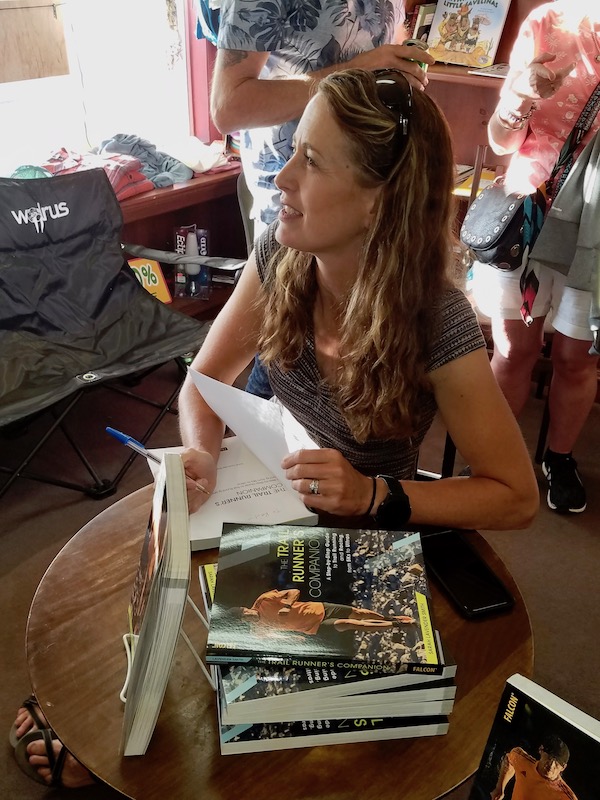
Having a great time, on the way to an age-group win, at the Silverton Ultra Marathon 55K last August. Photo by Howie Stern
Where will you run and race in 2020?
Now’s the time to plan the coming year’s run-related goals, because registration and lotteries for many races already have opened or will soon, and popular ones fill up almost immediately.
This is the time of year when clients contact me to outline their training blocks and brainstorm race goals for the coming year. I’m writing to share advice that I give them, and also to share how I’m shaping up my race plans and goals.
Some Do’s & Don’ts For Planning Your Training and Racing in the New Year
Dream big, then work backwards: Ask yourself, what is your number-one goal? What will make you most happy and proud at year’s end to say, “I did that”? It could be graduating to a new and challenging distance, such as running your first 50-miler. It could be PR’ing at a marathon to qualify for Boston. It could be returning to a race where you painfully DNF’ed to finish it strong. Or it could be planning and successfully executing your first fastpacking adventure. What excites you, and what do you want to learn from and take from this experience?
This goal should make you excited, because having an emotional attachment to it—and putting your heart into preparing for it—will be key to reaching it. It’s OK and normal to feel nervous about it, because feeling nervous means you care; but, the nervousness should feel more exciting and motivating than stressful and anxiety-producing.
The “work backwards” part involves getting out your calendar and plotting your life and your training to lead up to this goal. Can you realistically devote enough time for the specific, higher-volume training necessary in the three to eight weeks leading up to this goal? What long runs and practice races would be most beneficial to plan to prepare for the big goal? In the months leading up to it, how can you schedule your training and travel to enable you to train most specifically for your goal (i.e. training to emulate the conditions, climate, elevation profile, terrain and other factors similar to your goal event)?
Develop a Plan B: You may not have the opportunity to reach your big goal if it hinges on a popular event with barriers to entry. For example, you may have your heart set on running the Western States 100 in under 24 hours, but if you only have one ticket in the lottery pool, then you probably will have to wait several years to fulfill that goal. Therefore, it behooves you to come up with alternate goal scenarios if you can’t get into a sought-after race.
To plan for primary and backup goals, you need to stay on top of registration dates and be ready to register or enter a lottery as soon as it opens. For ultras, start by using Ultrasignup‘s Watch List tool; create an account, go to the event’s page, and hit the “watch” button to get email alerts when registration is about to open or sell out. Not all races are on Ultrasignup, so go to the event’s website, find out the registration date and process, and plug it into your calendar. Also follow the event’s social media pages to stay informed about it.
Get out of your comfort zone: I know a lot of runners who do the same ol’, same ol’ year after year, or they run and race in a relatively confined geographic region, because they’re used to it and it gives them a sense of tradition. There’s nothing wrong with that—if you like it, keep doing it!—but additionally, try to expand your horizons and challenge yourself with something new.
Be intentional when choosing races: Not every race will be an “A” goal in terms of performance and your emotional attachment to it. If you want to sign up for a race that’s not a top-tier goal, then ask yourself why you want to run it, and whether it’s worth the expense, travel and recovery time. Define your goals going into it. Perhaps you want to run a 50K as a deliberate supported training run, rather than a max-effort race, during your buildup to a goal 50- or 100-miler. In that case, you should build it into your training schedule without tapering for it, and use it to practice pacing and other strategies such as mid-race fueling for your longer goal ultra. Or, perhaps you want to run a race to support a friend who’s also running it, or to experience a destination. That’s all fine and good—just be deliberate about your intensions, and temper your performance expectations accordingly.
One of my favorite experiences this year resulted from a race I entered because I felt drawn to the destination (circumnavigating Prescott, Arizona) and the unusual distance of 88K or 57ish miles (report). I also wanted to use it as a buildup to a goal 100-miler. It turned out to be an adventure and great road trip, even if I didn’t do particularly well competitively.

Finishing the Whiskey Basin 88K last spring in spite of sustaining a deep gash on my quad from falling.
Build recovery into your calendar year: I generally recommend dividing a year into halves or thirds and designing two six-month training blocks or three four-month ones that build up to a depleting and challenging goal, followed by a period of rest. Then start a new block. This principle of periodization means your training volume and intensity will wax and wane, which is healthy and helps avoid burnout.
And now for the “don’ts”:
Don’t add too much to your travel itinerary or shoehorn races into family time: Let’s say you and your spouse want to take your kids to tour England for a special vacation. While making plans to visit Stonehenge and Windsor Castle, you learn about an ultra such as the Thames 100 and convince yourself that you could race it while you’re over there, and it would be a fantastic experience for all involved. Chances are, however, it could be a lose-lose situation: You’d have a crappy race due to travel fatigue, and your family would feel resentful because they have to spend two days standing on the sidelines while you do your thing.
It is possible to combine racing with vacation time; for example, in 2015, my husband and I celebrated our 25th anniversary by going to New Zealand. He supported me while I raced the Tarawera 100K, and then we had a fantastic week of hiking around the South Island. But we had to talk openly about how to structure this itinerary so that I could race but not sabotage our couple’s time.
Don’t let FOMO drive your choices: Some runners are drawn to be a part of “the scene”—the people and hype of an event—as much or more as they feel drawn to run the distance on that route. I’ve heard runners talk this way about The North Face Endurance Challenge 50-mile championship event in San Francisco, for example, because they want to run with a who’s who of notable runners and hang out at the finish line afterward. But does this race really fit well into your macro-level goals? If not, then go to spectate or volunteer instead.
Don’t overrace and spread yourself too thin: We like to celebrate ultrarunners who do “slams” (all the races in a series) or, to take one extreme example, who attempt to run 50 100-milers in a year, as Walter Handloser is doing. But consider the cost of spending so many weekends every month at a trail race—not just the financial cost, but the opportunity cost to do other things with your weekends, to rejuvenate with added rest and with less performance pressure, and to experience running long distances solo, on your own terms and according to your own training needs. I’ve encountered runners who feel they need to sign up for races to have the support to accomplish long training runs, to which I say: You should develop the mental fortitude and self-sufficiency to run long distances solo.
Don’t believe that longer always equals better and more impressive: A lot of ultrarunners I know tend to overlook the benefit of shorter races. If an event offers multiple distances, say 50K/50M/100M, they feel less worthy or more wimpy in choosing a shorter distance. But there’s no shame in dropping down in distance, as long as you define your goals and success for that event and go for it. I often encourage my clients to race a half marathon early in the season as a speed and cardio tune-up, or a road 5K, which can be a great substitute for a weekly speed session.
Check out the “My Race Calendar” sidebar on my blog to see how I folded some shorter races in between marathons and ultras.
How I’m Developing My Race Calendar For the New Year
At this phase in my life and running career, my goals are less performance-oriented and more about enjoying the experience as a whole. Connecting with a particular destination, and with the community of runners who’ll be there, matters as much to me as doing well competitively.
I feel strongly about only one specific performance goal: To successfully race a 100-mile high-altitude mountain ultra in the coming year, finishing strong rather than just surviving it. Out of all the 100s I’ve run, I’ve done well only on relatively runnable California courses. By contrast, my finishes at the Wasatch 100 (report) and Run Rabbit Run 100 (report) were sub-par suffer-fests, and then I DNF’ed at the Ouray 100. I need to finish a mountainous 100 this year for a Hardrock qualifier, so I will make that race my “A” goal, defining success not by whether I meet a particular time or finish in a certain place, but by executing it in a way that results in my best effort and most positive mindset.
All other races I’m calendaring are more for fun, for training and to experience the destination.
With that in mind, here’s how my 2020 race calendar looks so far:
February 21 Running Up for Air Grandeur Peak 12-hour, Salt Lake City, UT: This is an unusual timed event in the cold of winter in which runners run or hike up a snowy/icy/muddy high-altitude 3-mile peak with an elevation gain of almost 3000 feet, then run back down again, then repeat as many times as possible in the time limit. I’m doing it for the early-season kick-in-the-pants it’ll give my training, to challenge myself to run with greater agility and confidence in winter conditions, and to enjoy the people there. I have a lot of respect for the RD Jared Campbell, and the event raises money and awareness for a good cause, to fight wintertime air pollution around the Wasatch mountain range.
April 11 Lake Sonoma 50, Healdsburg, CA: I had no intention of returning to the LS50, even though I loved racing it and did well there in 2013 and 2016. Then RD Skip Brand launched a campaign to get 50 percent of the starters to be female, and to that end he’s inviting 30 notable female ultrarunners, thereby comp’ing their entry and letting them bypass the lottery. I was surprised and flattered to be one of the special invitees! This is an opportunity I can’t pass up, and now that I’m in Colorado, I’m feeling a little homesick for Northern California’s trails and its ultrarunning community. Therefore, I’m traveling back mid-April to do it! It’ll make an interesting back-to-back with my next race on this list, and it’ll serve as a peak training run for my big race in May (see below). The past two times I raced LS50, I had very specific time goals, which I met. Not so this time; I’m going to run it to celebrate being there amidst beautiful scenery and great people, and to get a solid extra-long run under my belt.
Here’s the cool invitation via their social media:
April 20 Boston Marathon: I BQ’ed at last year’s Napa Marathon, and though I have decidedly mixed feelings about road marathoning, I want to experience this iconic marathon once more in my lifetime (I ran it twice before, 2000 and 2009). Plus, it will be good training for the May stage race below. I’ll combine this with a family get-together, so I am setting the bar low for performance given travel fatigue, tired legs from the prior weekend’s 50-miler, and the distraction of family time with sightseeing. My goals are: run steadily the whole way without walking breaks; manage anxiety and overcome fears related to being in large crowds, especially in the shadow of 2013’s bombings; and celebrate the history and the runners that make Boston what it is.
May 17 – 23 Mauna to Mauna Ultra 155-mile self-supported stage race: After racing this event in its inaugural year 2017 (report), I didn’t think I’d go back because of the cost and because of the sense that “once is enough!” But then I won its sister event, the Grand to Grand Ultra, last month, and as a prize I got free entry into the Mauna to Mauna aka M2M! I’ve had a case of post-race blues following the phenomenal experience of the Grand to Grand, and I can’t deny I love self-supported stage racing. I also want to reconnect with several of the G2G/M2M alumni who’ll be there. And how can I pass up a chance to return to the Big Island?! The race directors put the event on hiatus for the past two years to secure permits to create the route they envisioned, and I’m really curious to see what M2M V.2 is like. So, I’m doing it in May! But, this time, I will sacrifice ultra-light pack weight for adequate clothing layers and food (if you read my 2019 G2G race report, lessons learned!). Having done so well competitively at the last G2G and M2M, by giving each race my all, I’m inclined to remove self-pressure for strong performance and really just enjoy an extra-special week as much as possible.

Working hard in the 2017 Mauna to Mauna Ultra stage race.
You know how I advised in the section above that you should build recovery into your year? I’ll take a couple of weeks off in late May and early June, then refocus on training for a 100M.
July 4 Rundola Hill Climb: This is an annual event in Telluride—a 1.3-mile “run” (read: hike) up a ski slope under the town gondola, gaining almost 2000 feet in elevation in a very short span. I like to do it every year and try to meet or beat the prior year’s time.
July 17 pacing a segment of the Hardrock 100: In my perennial quest to gain entry to Hardrock, I’ll continue to do what I can to experience the course as a pacer/crew. This summer I’m fortunate to have the opportunity to pace Tina Ure, a phenomenal longtime ultrarunner who recently turned 60 and who inspires me. Plus, this will be good training for my “A” goal 100 below.

Tina and me doing a fun run on the Sneffels Highline Trail above Telluride last July.
July 31 High Lonesome 100: This is the 100-mile Hardrock qualifier I hope to gain entry to and nail, because I’ve heard only positive reviews of it, and it’ll be a chance to experience a route in Colorado that’s new to me. But, it’s in high demand and is implementing a lottery this year, so I have to come up with backup plans in the likelihood I don’t get a spot. Plan B: return to Run Rabbit Run 100 in mid-September. Plan C if I can’t get into RRR100, then enter the lottery for Wasatch 100. Plan D: Head back east to Grindstone 100 in October.
August 22 Telluride Mountain Run: I love this 38-mile “baby Hardrock” that circumnavigates the mountains around my home town. I want to return since I took a break from it this year, and because I want to try to improve my time and tackle the white-knuckle skyrunning-style section that had me almost frozen with fear in 2018.
My fall schedule will depend on whether I do my first-choice 100-miler mid-summer or a backup option in September. I generally take the weeks between Thanksgiving and Christmas off from structured training to rest and crosstrain more.
To Get You Ready, Or As a Gift for Someone Else…
All my coaching advice on how to structure your training and how to prepare for race day is distilled in my book, The Trail Runner’s Companion: A Step-by-Step Guide to Trail Running and Racing, from 5Ks to Ultras. From now through year’s end, if you’d like a signed, personalized copy of the book, then you can email me or message me through my social media accounts; I will sign and mail it to you for the list price of $22.95 plus shipping. Or, you can buy it at a discounted price here on Amazon.
If you’ve already bought and read my book, thank you! Can you do me a favor and leave a customer review on that Amazon link? Customer reviews really help get the book noticed when people search for running-related books.

Book signing and talk last month in Kanab, Utah.
How about you? Please leave a comment below on how your 2020 plans are taking shape!

You’ll love High Lonesome! Best of luck in the lottery. I completed it this year (there was some suffering towards the end due to the altitude for this flatlander). I’m still pondering enterning the lottery for next year, but if not, I’ll be out there volunteering. It’s a great group of people.
Sarah,
Great post! I am absolutely committed to step into the ultra world in 2020. I have the registration date set in my calendar, so that as soon as the ball drops, and we have moved into the “roaring 20’s”, I will be signing up for the “Bethel Hill Moonlight Boogie 50 miler”. My wife has also said we are signing up for the “Ashville Marathon” and will run that in March. Neither of us has run over 13.1 miles in a stretch before, but I am determined to set new limits.
Thanks again for the inspiration to do what I have always dreamed of doing.